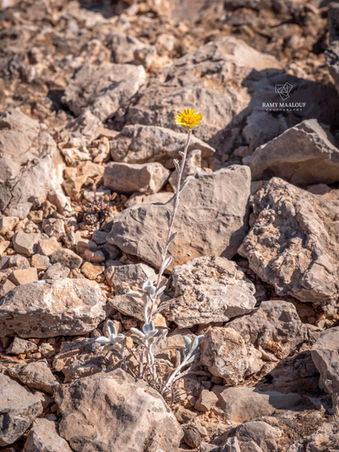Family |
Asteraceae
Rhanteriopsis lanuginosa
(DC.) Rauschert
Leb. Syr.
Rhanteriopsis lanuginosa (DC.) Rauschert
≡ Postia lanuginosa (DC.) Boiss.
≡ Asteriscus lanuginosus DC.
(First published under the current name in Taxon 31: 558; 1982. Treated in Nouvelle Flore du Liban et de la Syrie, vol. 3, p. 373; 1983, as Postia lanuginosa)
• Life-form & habit: Suffrutescent at the base, densely covered with an appressed woolly indumentum. Stems from a woody rhizome, erect, rigid, leafy, monocaphalous or in reduced corymbs of 2–3 heads.
• Leaves: Lanceolate, narrowed at base, with raised nerves, subdenticulate, tomentose.
• Inflorescence & flowers: Capitula slightly umbilicate. Outer involucral bracts few, foliaceous, more or less spreading, longer than capitula; inner bracts shorter, canescent, exceeded by ligules. Ligules deep yellow, about twice as long as the disk florets.
• Fruit: Achenes quadrangular, pubescent; pappus inner series reduced to 1–2 paleae (awn-like scales).
• Phenology: Flowers June–August.
• Habitat & elevation: Rocky terrains, montane steppe.
• Lebanese distribution: Between Baalbeck and Qamou‘at-Hermel; southwest of Hermel; sources of the Orontes.
• Syrian distribution: Damascus region (Aucher).
• Native range (Mouterde): Endemic to Lebanon and Syria .
⚠️ Taxonomic note: Originally described as Asteriscus lanuginosus DC., then placed in Postia by Boissier. Rauschert (1982) transferred it to Rhanteriopsis. Mouterde emphasized its distinction from P. microcephala by its larger capitula with conspicuous ligules.









